Growing Dill in Pots? Learn everything you need to know for proper dill plant care in this informative article.
Dill is a biennial herb but grown best as an annual. It can self-seed and keep growing like a perennial if you grow it in clumps on the ground. It’s an excellent choice for your container herb garden, as well.
Dill has feathery green fronds like a fern and has a sweet aroma like licorice and anise seeds. This popular kitchen herb is used both as a spice and herb. Harvest the fresh fronds to prepare salads, vegetables, sauces, meat, seafood, fish and curry dishes and use the seeds to flavor pickles, stews, sauerkraut, rice, and bread.
Botanical Name: Anethum graveolens
Other Names: American Dill, Aneth, Aneth Odorant, Anethi Fructus, Anethi Herba, Anethum sowa, Dill Herb, Dill Weed, Dillweed, Dilly, Eneldo, European Dill, Faux Anis, Fenouil Bâtard, Fenouil Puant, Huile d’Aneth, Indian Dill, Madhura, Peucedanum graveolens, Sua, Satahva, Shatpushpa, Sotapa, Sowa
USDA Zones: 3 to 11
Type of Plant: Biennial, grown as an annual.
Plant form and Size: Dill has feathery foliage that can grow up to 2-4 feet tall and 1-2 feet wide. (Depending on the variety)
Soil pH: 5.5 to 7.5
Types of Dill
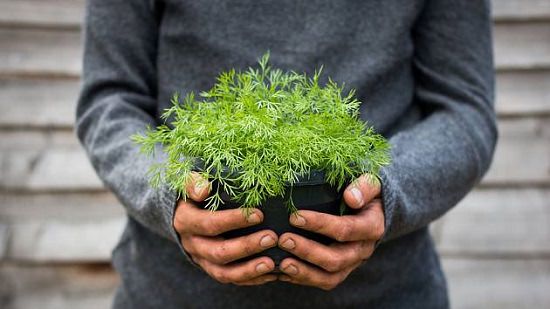
Dill has a range of varieties from Bouquet, Superdukat, Fernleaf, and Long Island Mammoth. Out of these, the Superdukat is particularly preferred for cooking needs and to grow in a pot, compared to Long Island Mammoth.
1. Bouquet
This showy variety has bright yellow flowers. This variety can grow large, usually between 24 to 36 inches tall. Because of this, it is best grown outdoors. Just be sure to plant this variety after the danger of frost has passed.
2. Superdukat
This compact hybrid variety of Dill is grown specifically to be more flavorful, and the size makes it suitable for container planting. This cultivar can grow between 12-24 inches tall but is slower to grow compared to Bouquet Dill. It is also reluctant to decline, so it has the benefit of being used for a more extended period. If you prefer more leaves than seeds, this is the variety to grow.
3. Fernleaf
A dwarf variety of Dill, this can be a great window garden plant for indoor growers as it doesn’t need much space to grow. It remains about 12-18 inches in height. This plant thrives best in a temperature range between 60-75 F (16 C to 24 C). Be sure to place it in a location where it can receive at least 6 hours of sunlight per day.
4. Long Island Mammoth
As with any variety of Dill, this plant forms taproots and doesn’t transplant well. So if you’re growing it in a container, be sure that it is at least 12-14 inches deep and wide because the Long Island Mammoth can grow up to a height of 36 inches with a spread around 24 inches. It’s commonly grown by commercial dill producers and thrives best outdoors.
Propagating Dill
You can’t grow dill from cuttings. You may try to root it in water, but this usually doesn’t work. Growing dill from seeds is the best option.
- Instead of growing dill seeds in seed trays, sow them directly in desired pots as dill plants form long taproots and don’t transplant well.
- Sprinkle dill seeds in pots and cover them with a 1/4-inch layer of soil mix.
- Keep the soil evenly moist while the seeds germinate, which is usually 7 to 10 days. You’ll have to wait till 21 days if the growing conditions are not optimum or seed quality is poor.
- Wait until the seedlings are 4-6 inches tall and thin them to one or two plants per pot, saving only the strongest ones.
- You can start the dill seeds indoors in spring, 4 weeks before the last expected frost date.
- Or, sow outside on your balcony or patio, after all the dangers of frost are passed and weather perks up to around 60 F (15 C).
- Keep sowing seeds every 3 weeks for successive planting. You can plant seeds in summer as well if it’s cool in your area.
- Grow dill in fall, too, begin planting last seeds at least 2 months before your first frost date.
Growing Dill in Hot Climate
If you’re growing dill in a warm climate (USDA Zones 9b-11), start seeds after the summer, in fall, when the weather is comparatively cold.
- Keep growing seeds successively to grow dill in winter and up to spring.
- It may die when your hot summer approaches unless you save the plant from heat.
- Shield it from the afternoon sun and hot wind and water it more often to keep the soil evenly moist.
- The plant will bolt in heat, keep trimming the flower buds before they open. Also, check out our article on how to grow dill in tropics here for more information.
Choosing a Container
Since dill forms a long taproot, choose a 5-gallon container that is at least 12 inches deep and wide similarly. In such a pot, you can grow one plant. For smaller varieties, select 10 inches deep pot. To grow a couple of dill weed plants together, get a much bigger pot.
Requirements for Growing Dill in Pots
Position
Provide a location that receives full sun or at least 6-7 hours of direct sunlight and good air circulation. You can grow dill in part sun, but it will not become bushier there than it would be in full sun.
If you’re growing dill indoors, keep it at a South or West-facing window for optimum growth. In a subtropical or tropical climate, save this herb from the intense afternoon sun, especially in summer.
Soil
Use well-drained, loamy potting soil when growing dill in pots. While it can tolerate poor soil, it’s a good idea to mix 20 percent aged manure or compost at the time of planting to make your growing medium slightly richer.
Watering
If the growing location is sunny and windy and the dill plant is growing in a clay pot, it will dry out faster, and you’ll have to water regularly to keep the soil mildly moist.
When growing indoors or in part sun, water only when the soil is about to dry. In the hot climate or summers, you’ll need to keep the soil moist.
Tip: Avoid overwatering to prevent root rot. Similarly, don’t practice overhead watering to stop fungal diseases and water around the base of the plant.
Staking
Dill is a floppy herb and tends to fall once it grows taller because of its weak and hollow stems. It’s better to use a plant stake like a bamboo stick or metal rod to support it.
Dill Plant Care in Pots
Fertilizer
Once your dill plant has grown several inches high and around 2-4 weeks older, it’s a time to fertilize it. Feed it every 4 weeks with a balanced liquid fertilizer in half of its prescribed strength on the label.
If you want to avoid chemical fertilizers, side-dress this herb with aged manure or compost, once or twice during the growing season.
Pruning Dill and Deadheading
- Pinch back the top growing tips of young 4-5 inches tall dill plant to make it bushier as you do with other herbs.
- If you’re harvesting this herb regularly, you don’t need to prune it.
- Don’t trim more than 1/3 of its growth at one time for either pruning or harvesting.
- Trimming the leaves from the top promotes bushier Dill growth. This forces the plant to grow outward instead of upward.
- Never allow your dill plant to flower unless you want to collect the seeds. This step increases its vegetative life.
- Remove as soon as the umbels of yellow flower buds (dill flower heads) appear, otherwise the plant flowers, form seeds and die.
Also Read: How to Prune Herbs
Pests and Diseases
Dill may get parsley caterpillars and tomato hornworms. Handpick the pests away from the plant. Aphids love this herb too, so keep an eye on them. In diseases, Leaf Spot and Mildew can be a problem, if you’ll practice overhead watering.
Harvesting Dill and Storage
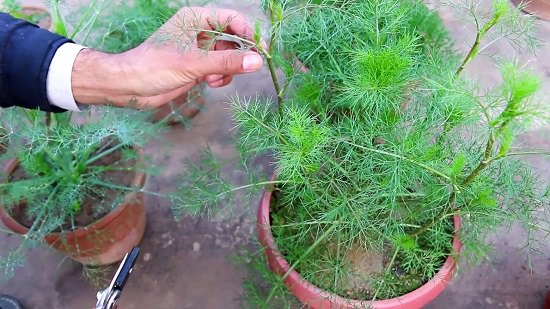
Harvesting Dill Leaves
Once the plant reaches an ideal height of 8 inches–Start harvesting. Use a garden snip or a pair of scissors to harvest according to your needs.
For this, nip off individual leaflets close to the stem and lay them in one layer on a baker’s rack or something similar. Once dry, keep them in an airtight jar.
Refrigeration
You can keep extra trimmings in the refrigerator, and they’ll remain fresh for a few days. Fold them in a damp paper towel, and secure them in a plastic bag. Or you can freeze entire stems and clip the leaves as you need them. Store them frozen in butter or vinegar, so that they leave a tangy taste in your cooking.
Tip: Dill leaves have the best flavor before flowering.
Harvesting Dill Seeds
After about 60-80 days from sowing, dill flowers will appear and seed. These seeds will be mature in 2-4 weeks, depending on the climatic conditions. Trim the seedheads when seeds turn flat and brown and before they fall on the ground.
Tip: If you’re not growing dill in pots for seeds, snip off the flower buds before they open and seed. This way, the plant will keep growing and direct its energy on vegetative growth.
Drying
Hang seedheads upside down in a paper bag, so that the dry seeds fall into it. Collect and store the organic seeds in an airtight container and use them as the way you want.


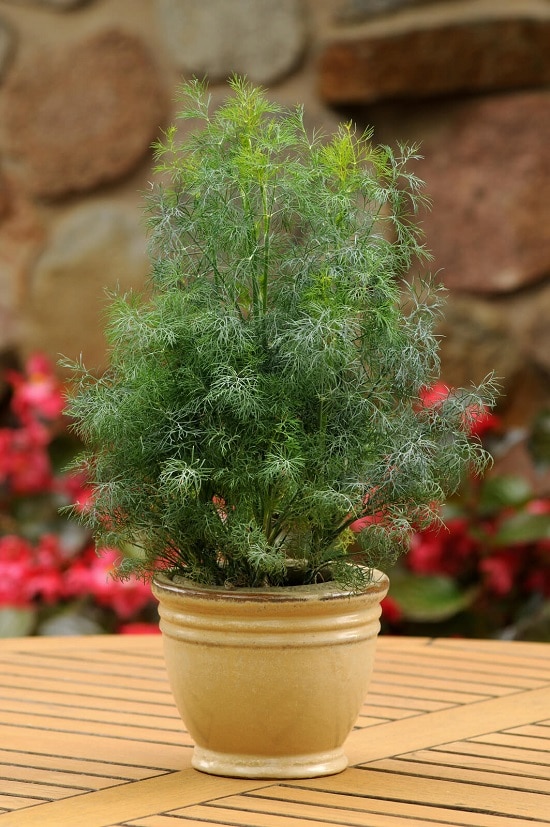
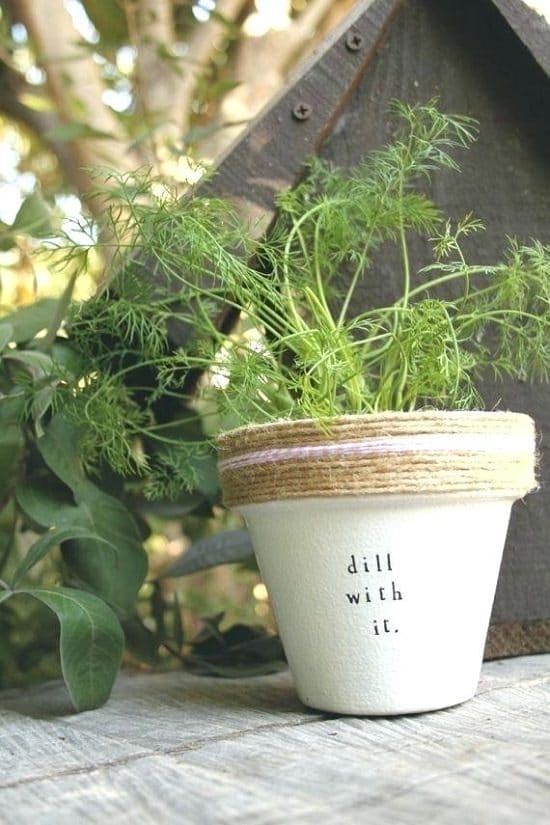
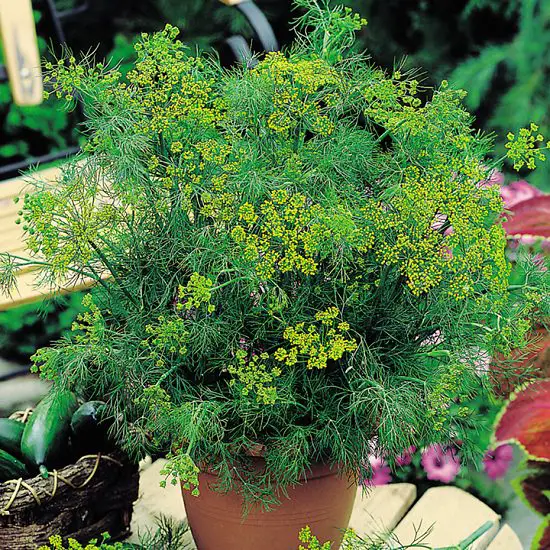


Wow!!! Great information. I like dill a lot.
Been looking to grow it indoors. I think maybe I can do it now.